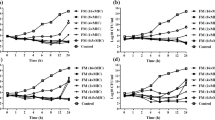Abstract
The in vitro post-antibiotic effect (PAE) of cefepime, cefotaxime, ceftazidime and imipenem on reference strains ofEscherichia coli, Enterobacter cloacae, Klebsiella pneumoniae, Pseudomonas aeruginosa andSerratia marcescens were evaluated by bioluminescence assay of bacterial ATP. In parallel with the PAE determination, initial killing and morphology studies were performed. Imipenem produced>1 h PAE on all strains tested, cefepime and cefotaxime on four strains and ceftazidime only on one of the strains tested. The length of the PAE on different strains did not correlate in the same way to MIC. Imipenem induced>1 h PAE at 1/4-2 MIC while the cephalosporins caused>1 h PAE at 4−256 × MIC. A PAE exceeding 1.2 h was seen concomitantly with spheroplasts but there was not necessarily strong (≥99 %) initial killing at the same time. The PAE duration at≥99 % initial killing varied between 2.0 h and 5.0 h. When the cephalosporins produced<1 h PAEs, this was seen concomitantly with production of filaments and weak initial killing. The bioluminescence method was not jeopardized by filament formation and no negative PAE was found in contrast to the viable count method. The study showed that neither a certain multiple of MIC, the presence of spheroplasts nor strong initial killing can predict the length of PAE for β-lactam antibiotics on gram-negative bacteria.
Similar content being viewed by others
References
Craig WA, Gudmunsson S The postantibiotic effect. In: Lorian V (ed): Antibiotics in laboratory medicine. Williams & Wilkins, Baltimore, 1986, p. 515–536.
Bundtzen RW, Gerber AU, Cohn DL, Craig WA Post-antibiotic suppression of bacterial growth. Reviews of Infectious Diseases 1981, 3: 28–37.
Eagle H, Musselman AD The slow recovery of bacteria from the toxic effects of penicillin. Journal of Bacteriology 1949, 58: 475–490.
Gudmunsson S, Vogelman B, Craig WA The in vivo postantibiotic effect of imipenem and other new antimicrobials. Journal of Antimicrobial Chemotherapy 1986, 18, Supplement E: 67–73.
Vogelman BS, Craig WA Postantibiotic effects. Journal of Antimicrobial Chemotherapy 1985, 15, Supplement A: 37–46.
Bustamente CI, Drusano GL, Tatem BA, Standiford HC Postantibiotic effect of imipenem onPseudomonas aeruginosa. Antimicrobial Agents and Chemotherapy 1984, 5: 678–682.
Odenholt I, Isaksson B, Nilsson L, Cars O Postantibiotic and bactericidal effect of imipenem againstPseudomonas aeruginosa. European Journal of Clinical Microbiology & Infectious Diseases 1989, 8: 136–141.
Rennerberg J, Walder M Postantibiotic effects of imipenem, norfloxacin, and amikacin in vitro and in vivo. Antimicrobial Agents and Chemotherapy 1989, 33: 1714–1720.
Bergan T, Carlson IB, Fuglesang JE An in vitro model for monitoring bacterial responses to antibiotic agents under simulated in vivo conditions. Infection 1980, 8, Supplement 1: 96–102.
Rescott DL, Nix DE, Holden P, Schentag JJ Comparison of two methods for determining in vitro post-antibiotic effects of three antibiotics onEscherichia coli. Antimicrobial Agents and Chemotherapy 1988, 32: 450–453.
Ravizzola G, Caruso A, Manca N, Savoldi E, Turano A In vitro activity of cefotetan and other cephalosporins ofKlebsiella and resistance to inactivating bacterial enzymes. Journal of Antimicrobial Chemotherapy 1983, 11, Supplement A: 133–138.
Baquero F, Culebras E, Patrón C, Pérez-Díaz JC, Medrano JC, Vicente MF Postantibiotic effects of imipenem on gram-positive and gram-negative microorganisms. Journal of Antimicrobial Chemotherapy 1986, 18, Supplement E: 47–59.
Lorian V, Ernst J, Amaral L The post-antibiotic effect defined by bacterial morphology. Journal of Antimícrobial Chemotherapy 1989, 23: 485–491.
Hanberger H, Nilsson LE, Kihlström E, Maller R Postantibiotic effect of β-lactam antibiotics onEscherichia coli evaluated by bioluminescence assay of bacterial ATP. Antimicrobial Agents and Chemotherapy 1990, 34: 102–106.
Nilsson L, Sörén L Selective growth of resistant variants during incubation ofEnterobacteriaceae with four aminoglycosides. Journal of Antimicrobial Chemotherapy 1986, 18: 317–324.
Kronvall G, Myhre E Differential staining of bacteria in clinical specimens using acridine orange buffered at a low pH. Acta Pathologica et Microbiologica Scandinavica (B) 1977, 58: 249–254.
Molin Ö, Nilsson L, Ånséhn S Rapid detection of bacterial growth in blood cultures by bioluminescent assay of bacterial ATP. Journal of Clinical Microbiology 1983, 18: 521–525.
Greenwood D An overview of the response of bacteria to β-lactam antibiotics. Reviews of Infectious Diseases 1986, 8, Supplement 5: 487–495.
Hörnsten EG, Nilsson LE, Elwing H, Lindström I Effects ofEscherichia coli spheroplast formation on assays of H2 and adenosine triphosphate based ampicillin susceptibility tests. Diagnostic Microbiology and Infectious Disease 1989, 12: 171–175.
Rolinson GN, MacDonald AC, Wilson DA Bactericidal action of β-lactam antibiotics onEscherichia coli with particular reference to ampicillin and amoxycillin. Journal of Antimicrobial Chemotherapy 1977, 3: 541–553.
Bergan T, Carlsen IB Bacterial kill rates of amoxycillin and ampicillin at exponentially diminishing concentrations simulating in vivo conditions. Infection 1980, 8, Supplement 1: 103–108.
Kahan FM, Kropp M, Sundelof IG, Birnbaum J Thienamycin: development of imipenem-cilastin. Journal of Antimicrobial Chemotherapy 1983, 12, Supplement D: 1–35.
Then RL, Angehrn P Ways to overcome cephalosporinase-mediated β-lactam resistance inEnterobacter cloacae. Chemioterapia 1985, 4: 83–89.
Manek N, Andrews JM, Wise R The postantibiotic effect of imipenem. Journal of Antimicrobial Chemotherapy 1986, 18: 641.
Author information
Authors and Affiliations
Rights and permissions
About this article
Cite this article
Hanberger, H., Nilsson, L.E., Nilsson, M. et al. Post-antibiotic effect of beta-lactam antibiotics on gram-negative bacteria in relation to morphology, initial killing and MIC. Eur. J. Clin. Microbiol. Infect. Dis. 10, 927–934 (1991). https://doi.org/10.1007/BF02005446
Issue Date:
DOI: https://doi.org/10.1007/BF02005446




